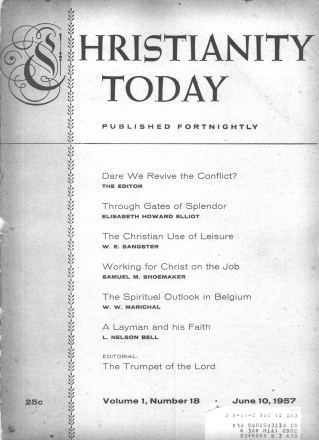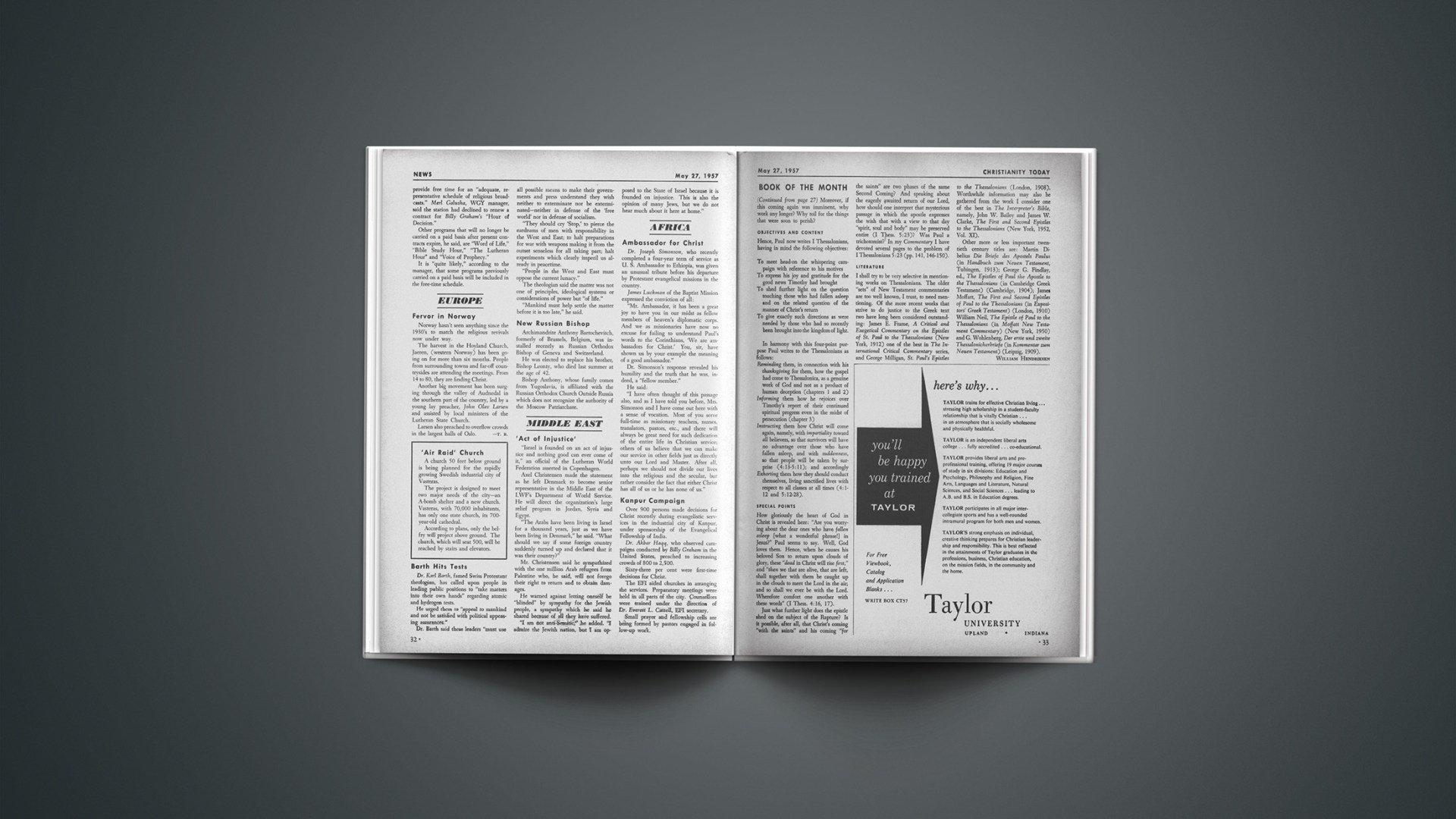What is the Christian attitude to leisure? Is the old identification of holidays and holy days still valid, or is the subject of no religious significance at all?
The Opposition To Leisure
Some Christians—especially those in the Puritan tradition—have had little interest in holidays. Holidays to them have seemed largely a waste of time, and in their noble miserliness with their moments leisure has almost been deemed a sin.
John Wesley said as a young man: “Leisure and I have parted company. I am resolved to be busy till I die.” He was busy till he died. That amazing resolution of his youth he kept to old age, and he only ceased to work when he ceased to live.
But I am bold to say that John Wesley’s opposition to leisure was mistaken, and if anybody feels that that is a severe judgment on a great man, I would point them to the greatest example of all. It was Jesus who said to his disciples: “Come ye yourselves apart … and rest a while.”
Leisure Has Its Place
A normal man who never rests (and John Wesley was not a normal man) gets taut, overwrought, strained and ultimately breaks down. Leisure has its place in life. There is a rhythmic law underlying all existence; an ebb and flow; a movement of periodicity. And in that ebb and flow, work and leisure both have a place.
It is with the mind as with the soil. If you want to get the best out of your land, you must change the crops and sometimes even let the land lie fallow. One who never slackens the bow becomes at the last a work-ridden neurotic.
Moreover, modern life is going to provide more leisure than the mass of people have ever known before. The burden of work is to be borne increasingly by the machine. Despite the urgency of the times, many business houses are committing themselves to a shorter work week. Think of it! Only five working days in every week. That means two whole days off—normally, I suppose, Saturday and Sunday.
The Use Of Free Time
How is that leisure to be used? In some ways the battle of free time is over. The harder question—“what to do with the free time”—has now to be met.
A generation ago some people hardly knew what to do with a week’s holiday when they were given it.
A friend of mine, a Christian layman and the proprietor and owner of a chain of provision stores, came to the conclusion some years ago that, as a Christian man, he ought to be giving all his employees a week’s holiday with pay. He told me afterwards, with some amusement, of the reaction of the manager of one of his shops.
The man protested. He told the proprietor to his face that he did not want a week’s holiday, that he wouldn’t know what to do with it when he had it, that he supposed this was a way of pushing him out of his job—and did he think anybody else could run the shop if he wasn’t there? When my friend insisted that he take the week off, he spent the whole week hanging around the door of the shop, nodding to his customers as they went in and out and making rude remarks about the under-manager who was trying to do his job. His happiness when the week was over was unbounded, and when he tied on his apron on Monday morning, he said fervently to his employer, “Thank God, that’s over.”
Personal Preferences
No one with intelligence will deny, I think, that the mass of people seem to make a poor use of leisure now that it is theirs. Not that we must be superior about this. People enjoy themselves in their own way. One man’s fun is another man’s boredom.
Sir Harold Nicolson, in the columns of The Spectator, made a slashing attack some time ago on people who make a hobby of collecting stamps. He stigmatized them as people with an adolescent mind, and I need hardly say that the philatelists took up the challenge with gusto, and the honors were even at the last.
Unworthy Recreation
People differ, of course, in the things that recreate their minds, but surely we can say without offensiveness that the recreations to which the mass of people turn seem somewhat unworthy.
Think of the hours and hours men stand about in saloons engaging—if one judges by one’s recollection of Army canteens—in inane arguments, often on subjects they know little about and in which the honors go to the man who bawls the loudest. When one thinks of the hours spent and the money wasted filling up football-pool coupons (on which it is estimated that in Britain many millions of pounds change hands every year); when one thinks of the attraction and the banality and the dangers of these so-called fun-fairs, one cannot help wondering if nothing can be done to lift the level of leisure time spending and get it into the minds of people that even leisure is not ours to squander but is given us by God for a use in which mind, body and soul may be refreshed and strengthened.
What advice, then, can we give about the use of leisure?
The advice I would like to give would be an adaptation of Augustine’s famous rule: “Do what you like but learn to like the best things.”
If it is something you honestly don’t like, it can’t be leisure. One of the differences between work and leisure is that work must be done whether you like it or not, but leisure ought to allow room for the expression of preferences and the satisfaction of wholesome desires.
Let Leisure Be Healthy
Let your occupation in leisure be healthy.
Some people rush and tear about even on holiday so that they return to their work worse rather than better for the change. Vigorous activities ought to be interspersed with periods of quiet. Even the hearty extrovert, coping with a glut of social engagements and declaring that he “never needs a rest, only a change,” would be all the better for turning his thoughts inward occasionally, correcting the compass of his life, thinking on purposes and aims and taking his bearings in the universe as a whole.
I think it is better for young men to play games rather than to watch them; though the years come soon enough, of course, when it must be bowls rather than football. But if we can keep the parasite of gambling out of sport, I am going to say that it is a grand thing that the normal Christian takes a healthy interest in wholesome games. To see a vast crowd of men sitting in the sun and taking the keenest delight in a match is—to me—a goodly sight.
Some psychologists have said that one of the tragedies of the German people is that they have never learned to play (in the sense that the term is understood in America and in Britain), and that is, perhaps a chief reason why Germany is one of the countries in the world where the suicide of children is a not unfamiliar phenomenon.
Let Leisure Be Cultural
In the second place, don’t be afraid of a bit of culture. I think it was Goring who said, “Whenever I hear the word ‘culture’ I reach for my gun.”
None of us wants to copy Goring. The recreational pursuits that give the deepest joys require the most mental concentration.
Jeremy Bentham, the utilitarian philosopher, said: “Pleasure for pleasure being equal, push-pin is as good as poetry.”
You see what he meant? He was saying, in effect, that people who have had educational advantages must not be superior, and that if a simple game like push-pin—which was as common, I fancy, in the 18th century as darts are now—gave the people who played it the pleasure they sought, then it was as good as the most cultural interest in verse.
But that is just the point where I would challenge Bentham. It is not in the power of these shallow little occupations to give the joy that deeper pursuits can give. The people who have known both will bear me out there. Think of the joys a music lover has, or a student of the appreciation of art, or one really informed in the delights of our literature, or a really expert gardener.
Snakes and ladders, and ludo, and whist, and movies and watching other people play games are all right, but the deeper joys make the deeper demands and yield the deeper return.
The effort it takes to understand the best in music—if you have the latent capacity to appreciate it—or the best in art, is all worth it. Be on your guard against always wanting to be entertained. Learn to entertain yourself. Have a mental life of your own. There is bound to be something grand for which you have a latent aptitude. If it is not music, it might be fine art. If it is not books, it might be nature in her deeper ways. Get the bit of education it requires to appreciate the better thing and work at it yourself.
I ask the people reading this who are now in middle life whether it is not a fact that when we were children we were much more ready and skillful in making up our own games than children appear to be today? At the moment when we would have set about making up a game in our childhood, the child of today seems to whimper for the money to go to the movies.
God has crammed life with wonderful joys, but they are not all on the surface. It calls for some effort to nourish the taste, but the taste for higher joys is latent in us somewhere.
Let Leisure Be Spiritual
Finally, in all use of your leisure have a thought for your soul.
It has been a complaint of some people for many years that they don’t go to church on Sunday because it is their only opportunity of recreation in the week. With many, that was plainly not true. It might have been true of some. With others it was nothing but a shallow excuse.
But even that shallow excuse is likely to go now. With increasing leisure there will be opportunity for recreation on Saturday and the opportunity to consecrate time for God on the Sunday as well.
Don’t let us celebrate the acquisition of more leisure by a greater carelessness about our souls. A soul doesn’t grow on its own. It needs nourishment, periods of quiet, food for its sustenance. A man or woman without a concept of reverence is incomplete and without a window open to heaven.
Work is very absorbing in some lives, especially with the housewife and mother. She knows as well as the businessman what the hymnwriter meant when he said:
Around us rolls the ceaseless tide
Of business, toil, and care,
And scarcely can we turn aside
For one brief hour of prayer.
But we must! Frankly—as I see it—this is the first call on our leisure: to maintain our commerce with our God.
W. E. Sangster was President in 1950 of the Methodist Church in Great Britain. He is author of numerous volumes throbbing with evangelistic concern, and is an exponent of the relevance of Christian conviction to all the spheres of life and culture. Latest of his writings is They Met at Calvary. His earlier works include Methodism Can Be Born Again, These Things Abide, Ten Statesmen and Jesus Christ, The Pure in Heart, Approach to Preaching, Teach Us to Pray and Let Me Commend.












